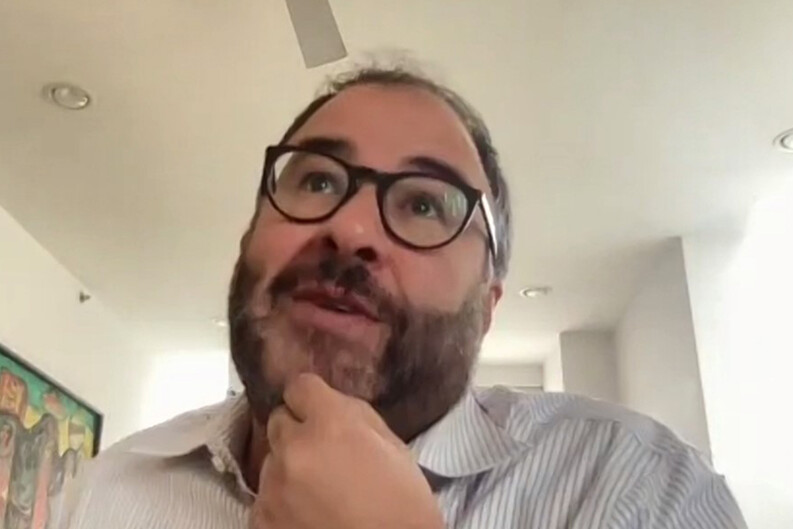Human Rights Workshop: Guantanamo Litigator on Lawyering in a Lawless Space

Baher Azmy, Legal Director of the Center for Constitutional Rights (CCR), spoke at the Sept. 9 Human Rights Workshop about the challenges of legal advocacy in a space that exists outside the law: the military prison at Guantanamo Bay.
In his presentation, “Guantanamo: 20 Years of Lawyering in Lawless Space,” Azmy detailed cases he has litigated related to the rights of Guantanamo detainees such as Murat Kurnaz, a German resident of Turkish descent. Azmy, who also teaches constitutional law and directs the Civil Rights and Constitutional Litigation Clinic at Seton Hall University School of Law, represented Kurnaz until his release in 2006.
On Azmy’s first visit to the military prison to meet his client in 2004, Kurnaz “looked like a castaway on a desert island,” he said. Azmy handed Kurnaz a handwritten note from his mother, his first message from her after three years of speaking only to military guards. According to Azmy, Kurnaz’s mother wrote that he would be visited by an American lawyer “who you can trust.” He recalls seeing Kurnaz’s “pained expression reading his first taste of humanity in three years.” Later that month, Azmy filed a case to challenge the legality of his indefinite detention.
Guantanamo, Azmy explained, is designed to maximize pressure and “create a system of learned helplessness” to overpower resistance to interrogation. Guantanamo’s legal status, Azmy suggested, contributes to detainees’ sense of helplessness. “Lawyers would tell a client, ‘Please don’t talk to interrogators,’” Azmy explained. “The most dangerous thing to the essence of Guantanamo is hope. A lawyer can say, ‘Tell me your story. I am on your side. I will help you.’”
Azmy said the prison, which he called “system of total violence and torture,” has been located outside the U.S. to avoid legal constraints and limit detainees’ access to lawyers and help through the law. As a result, lawyers even accessing Guantanamo strike a blow against its repressive environment. “These detainees had no idea they had a lawyer,” he said.
By 2004, Kurnaz’s case reached the U.S. Supreme Court and “[President] Bush was arrogant, claiming maximal power vis-à-vis the court,” Azmy said. Making an argument about the rights of “terrorist subjects” against alleged threats to national security proved challenging. Instead, lawyers framed Guantanamo as a rule of law issue, depicting the detentions as an “anomalous experiment” in America’s domestic policy. Other than during the U.S. Civil War, Azmy explained, the U.S. government had not typically detained people without access to the law.
Supreme Court rulings on these petitions allowed the CCR to construct a global network of lawyers and allies to represent hundreds of detainees. “It was the greatest mass defense effort in U.S. history,” Azmy said. Lawyers were also able to obtain declassified evidence against Kurnaz that had previously been withheld from him. Azmy was thus able to learn that, Kurnaz was in detention because of a friend’s alleged acts in 2003 — while Kurnaz was already in prison. “The statements exonerating him in the classified file were not provided in the tribunal,” Azmy said.
Azmy was shocked when the Bush administration passed the Military Commissions Act of 2006, suspending habeas corpus. “Our aspiration for rights, which I believed in, fell away,” Azmy recalled. Rights, he said, do not exist in a vacuum, to be deployed as needed. Instead, “rights are ultimately contingent on politics and not the other way around ... institutions need to be able to respect your claim of right.”
The problem Guantanamo detainees faced, Azmy said, was that they had “no meaningful durable rights and these could be taken as soon as they were conferred.” He added: “As a younger attorney at the time, I was just agog and shocked at the arrogation of power and how it worked in the world.”
President Obama pledged on his first day in office to close the prison by the new year, after hundreds of lawyers had exposed stories of innocence and torture that, Azmy said, “devastated the central myths of Guantanamo.” With Obama’s broken promise and the U.S. Supreme Court’s rejection of multiple Guantanamo-related cases in 2011, detainees began to despair. People were “left utterly hopeless,” Azmy explained, and some resorted to committing suicide, which the military would classify as “manipulative self-injurious behavior.” In 2012, a massive hunger strike by detained individuals resulted in them being subjected to “brutal force feeding.” Azmy noted that Obama once again committed to releasing more detainees to no avail.
Azmy has since been thinking about different forms of lawyering as part of a process of liberation. Lawyering as principle, he said, involves “standing up for some value,” changing minds, and “fueling long term campaigns.” Lawyering as hope and resistance symbolizes how lawyers can mean “help is on the way” and provide hope amidst despair. Lawyering as storytelling suggests, according to Azmy, that “once lawyers are paired with clients, stories can be told.” One can also view lawyering as unification, liberation, and love. “Lawyering,” Azmy said, “can be life-altering.”
He ended with a final image of Kurnaz as he was released in August 2006. “During the dozens of hours that we had spent in Guantanamo, his ankle had been chained to the floor,” Azmy said. “That day, for the first time, I saw Murat walk.”


